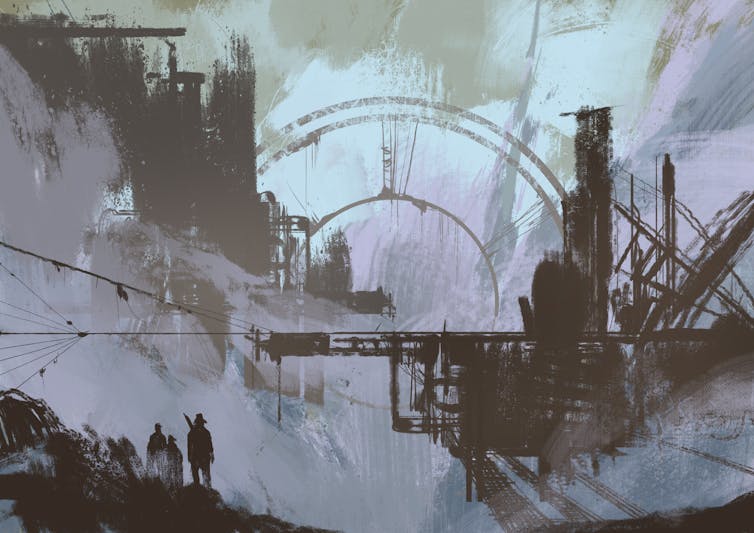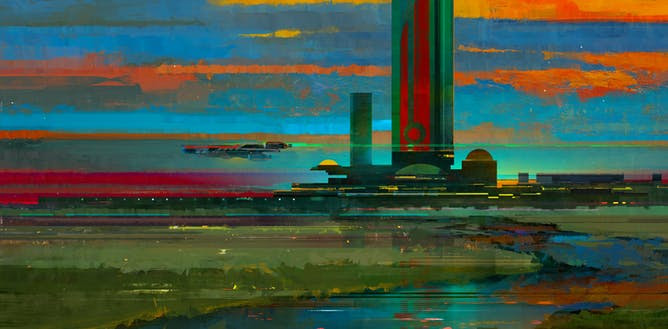Lockdown is preventing many of us from travelling to cities we might have been longing to visit. But we can take this opportunity to explore urban landscapes that exist in other worlds. Three experts introduce cities featured in novels, poetry and video games.
Utopian London
Utopia seems like a good place to spend some time just now. William Morris’ novel News from Nowhere (1890) takes Londoner William Guest, tired of the dirty city and his hard work, to a future London where the birds sing in the trees again. People are content, with rich full lives in a place where pollution, poverty and misery are forgotten. The medieval aesthetics and socialist politics of this ideal future are improbable and optimistic, but delightful and vividly portrayed.

William Morris/Wikimedia Commons, CC BY-NC
Though Guest is later returned to the dingy present of Victorian London, he takes back hope: of a changed world where everyone’s worth is recognised and work and leisure are productive and inspiring. The novel concludes that this future may yet be realised with communal effort, so that this beautiful, ideal London “may be called a vision rather than a dream”. ST
A bustling city
City Trees, a short poem by Edna St Vincent Millay (1921), recalls us to a time when our cities were busy places, rather than the deserted streets of a locked-down world. Millay’s poem evokes a pause, a loitering under a tree, perhaps seeking shade or shelter from the rain, straining to hear the “thin and sweet” sound a tree makes. In my head this is in Paris, though it could be any city street or country lane.

Wikimedia Commons, CC BY-ND
This simple poem offers a moment of stillness in a busy place, and reminds us to look up, down, around, to pay attention to the tiny sounds and sights and movements which are signs of urban nature. Millay invites us to pay attention to the quieter aspects of life which are so often lost in the day’s noisy rough-and-tumble. ST
New Crobuzon
The author China Miéville is a Londoner since childhood and cities appear in most of his fictions. The city of New Crobuzon was first introduced in his novel Perdido Street Station, published in 2000. A congested, polluted capital whose factories run on alchemy, New Crobuzon is home to a vast array of human, non-human and hybrid creatures. The majority are exploited and abused by the ruling oligarchy and its state militia.

Tithi Luadthong/Shutterstock
The city, though, is perpetually on the point of collapse. The Dickensian echoes of this fantastical yet heavily industrialised landscape suggest that New Crobuzon is only a slightly distorted version of Miéville’s London. PM-R
Viriconium
In his acknowledgements to Perdido Street Station, Miéville credits the influence of M John Harrison. Harrison’s Viriconium series, published between 1971 and 1985, may be fantasy’s best kept secret. The titular city is set on a far-future Earth and salvaged from scraps of technology. In the first novel, The Pastel City (1971), it seems to be a physical location. By the first sequel, A Storm of Wings (1980), it has become – like Joyce’s Dublin – an externalisation of the protagonists’ mental state.
In the third novel, In Viriconium (1982), the city is exposed as a fiction that disguises our real world yet also seeps into it. As Harrison later remarked, Viriconium is an invitation not “to control things. Learn to love the vertigo of experience instead.” PM-R
Novigrad
The Free City of Novigrad appears in the video game Witcher 3: Wild Hunt. The games and subsequent Netflix season are based on a series of fantasy novels of the same name, by Andrzej Sapkowski. Novigrad is a bustling economic hub, with busy trade routes exporting grain to the four kingdoms of the game’s world. The busy docks, lively squares and criss-crossing canals are modelled on medieval Amsterdam, and capture a snapshot of a crowded and dirty antique European capital. You can explore the oak-beamed townhouses which line the main thoroughfares or the dank monster-infested sewers.
Novigrad is inhabited by throngs of medieval townsfolk who you can interact with: exchanging conversation or trading goods and become embroiled in arching narratives or simply gaining an insight into the everyday life of a Novigradian. The city might not be a picture-postcard European city break, but the lavish detail makes it compelling nonetheless. DC
The Vault
Fallout Shelter is a free-to-play simulation game for smartphones and tablets. It is a twisted slice of American pie set in a post-apocalyptic future. Playing the game, you are the overseer of a vault, a subterranean city that has become a haven for dwellers, who are the remnants of humanity escaping the arid nuclear wasteland above.
The vault is styled in the futuristic Raygun gothic aesthetic – bright and energetic, with art deco overtones. However, the subtle lighting, muted palette and closeted rooms compromise the optimism and unbridled futurism of the style’s 1950s Americana.
The game unfolds as you oversee the day-to-day activities of your dwellers while sending teams out into the wasteland. Here, they scavenge for raw materials and complete quests as part of an engaging multi-faceted narrative. DC![]()
Serena Trowbridge, Reader in Victorian Literature, Birmingham City University; Drew Cattanach, Lecturer in Computer Games Development, University of Westminster, and Paul March-Russell, Lecturer in Comparative Literature, University of Kent
This article is republished from The Conversation under a Creative Commons license. Read the original article.







